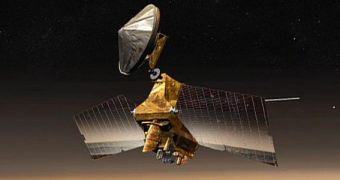On Sunday, March 9, the NASA Mars Reconnaissance Orbiter (MRO) unexpectedly entered safe mode while orbiting the Red Planet, mission controllers at the NASA Jet Propulsion Laboratory (JPL) in Pasadena, California, announce. The exact reasons why this occurred are currently unknown, but experts have already recovered most of the spacecraft's functionality.
Just before the probe entered the precautionary safe standby mode, mission controllers recorded an unscheduled swap from the main computer aboard the spacecraft to the second one. Already, JPL investigators are working on restoring full capabilities to the MRO, which plays an important role in Martian orbit in addition to observing the surface of our neighboring world.
NASA says that its experts expect the probe to make a full recovery, though the exact cause of the malfunction will have to be established in order to prevent similar occurrences in the future. Initially scheduled to conduct a 2-year primary mission, the MRO has been surveying the Red Planet for close to 9 years.
One of the more severe aftermaths of the computer shutdown is that all communication relay services between MRO and other NASA missions on the surface of Mars have been discontinued. The Mars Science Laboratory (MSL) rover Curiosity and the Mars Exploration Rover (MER) Opportunity are both relying on the orbiter to send data back home, via the NASA Deep Space Network.
Both machines have high-gain antennas capable of contacting Earth directly, but mission controllers usually prefer to conserve power by sending data to MRO, which in turn forwards it to Earth. For Opportunity, this is important because it operates on partially-dust-covered solar panels, instead of Curiosity's nuclear-powered motor.
JPL scientists say that all rover communications have been diverted to the NASA Mars Odyssey orbiter, at least for the time being. MRO will resume its role when all functionality has been recovered. The orbiter's science observations of the Red Planet have also been discontinued by the glitch.
“The spacecraft is healthy, in communication and fully powered. We have stepped up the communication data rate, and we plan to have the spacecraft back to full operations within a few days,” comments MRO project manager Dan Johnston, from JPL.
The spacecraft is no stranger to entering safe mode. Thus far, it has done so four times, including in November 2011. Additional computer reboots occurred for reasons other than the main processing core. Unfortunately, scientists at the Lab have yet to determine precisely why these events occurred.
MRO was manufactured by an international collaboration of companies and universities, including Lockheed Martin, the University of Arizona, the Applied Physics Laboratory at Johns Hopkins University, the Italian Space Agency, and Malin Space Science Systems.
It was launched into space aboard a 401-configuration Atlas V delivery system, from Space Launch Complex 41 (SLC 41) at the Cape Canaveral Air Force Station, in Florida. After taking off on August 12, 2005, the spacecraft spent the next few months on its way to Mars, before finally achieving insertion in orbit around the Red Planet on March 10, 2006.

 14 DAY TRIAL //
14 DAY TRIAL //